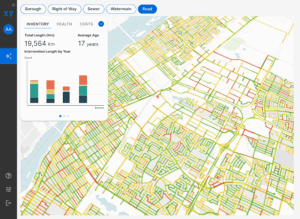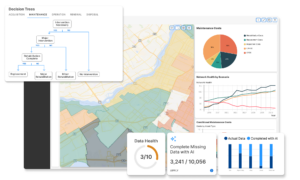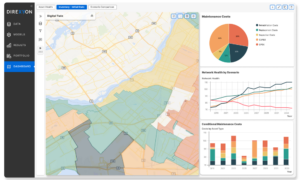What asset data do municipalities need?
A major reason municipalities struggle with asset management is due a lack of data collection and availability. Without quality, accessible asset data, it can feel impossible to know which infrastructure assets need to be maintained, repaired, or replaced.
Good asset data is a crucial piece of asset management. However, it’s important to recognize there’s no such thing as perfect data. Even with the best data collection and governance practices, gaps, and inaccuracies can occur.
If your municipality doesn’t know what asset data you need to make data-driven decisions, use this guide to get started.
Asset data's role in decision-making
Every service municipalities provide begins with infrastructure.
Watermains deliver clean water, well-maintained roads allow enable efficient and safe transportation, and sewage systems ensure effective waste management. Without these assets in good working condition, municipalities parks, community centres, and a thriving local economy will be elusive.
And every single infrastructure asset degrades with time and use. With only so much budget available to maintain, repair, and replace infrastructure assets, data allows to municipalities to effectively allocate funds and prioritize interventions.
For example, asset data can indicate to municipal asset managers that a water main in a densely populated area is in very poor condition. Meaning it is more likely to fail, causing significant water disruptions and health risks due to water contamination.
Meanwhile, a heavily used road a few blocks over may show some signs of wear and tear, but not an immediate risk to safety.
With this information, the choice is clear: repair the water main. But which data points do we use to make this assessment?
The asset data municipalities need
While smart infrastructure has a certain allure, municipalities do not need sensors embedded in every road, water main, sewer, or municipally-owned facility to gain a comprehensive understanding of their infrastructure assets.
The data municipalities need to bolster their asset management includes:
Inventory data
Executing an asset management plan first demands a comprehensive list of all infrastructure assets.
An asset inventory should all roads, sewers, and water pipes in a municipality, but it also unique characteristics of each asset. Characteristics could include:
– Age
– Capacity
– Material
– Dimensions
Given that most municipal infrastructure in Canada was built between the 1950s and 70s, it’s common for some of these figures are missing.
Thankfully, modern asset management solutions are equipped with machine learning and artificial intelligence to fill any gaps in the inventory until the exact data is collected.
Inspection data
Inspection data refers to any information collected during regular assessment of municipal infrastructure assets.
This may include:
– Condition assessments
– Maintenance records
– Usage data
– Compliance checks
– Performance metrics
Accurately collecting this data requires systematic and thorough inspections, utilizing standardized methods and technologies to ensure consistency and reliability. Enterprise Asset Management systems can be instrumental in standardizing collection efforts, providing tools to automate data collection, organize records, and even predict asset performance.
Spatial data
Asset spatial data, or Geographic Information System (GIS) data, allows municipalities to gain better insights into their infrastructure’s geographic context. This enables municipalities to visualize how an asset fits into the larger network it manages as well as its relationship to the area’s population.
Asset spatial and GIS data is collected through a few different methods, which includes:
– GPS
– Remote sensing
– Field surveys
– Digitizing existing maps
– GIS data sharing
GIS data is particularly useful for asset management software with advanced visualization, enabling condition rating overlays, service levels, performance indicators, and projects across the municipality.
These features can be particularly useful for enhancing the readability and accessibility of asset management data.
Financial data
Any financial reports, operations and capital budgets are essential to properly allocate the funds to maintain, renew, or replace municipal assets.
This financial data ultimately determines what actions municipal asset managers can undertake.
A centralized solution for asset data
A major reason why municipalities tend to assume they don’t have the right asset data to conduct strategic asset management is due to data silos.
Frequently, the data is there, it’s just in a format or folder used by a specific department.
This ceases to be an issue if all asset data is centralized in a single solution.
And in the event the asset data must be collected from scratch, a centralized solution can also prevent any gaps by standardizing how data is collected and stored.
The major benefit of storing all this information in a centralized solution is that it provides municipalities with an integrated understanding of their assets: what they are, where they are located, their current condition, and the associated costs of potential decisions.
Filling data gaps with a centralized solution
Another major benefit of centralizing asset data in a single solution is ability to fill any gaps with machine learning and artificial intelligence.
A centralized solution for asset data with machine learning and artificial intelligence capabilities, like an Asset Investment Planning (AIP) solution, can infer asset characteristics, cost, inspection history, and more based on the assets around it.
Imagine there’s a water main with no asset characteristic data or inspection history. But city officials can confirm its there. An AIP solution can use machine learning to infer that because similar nearby segments are 40 years old, are made of galvanized steel, and have no history of frequent repairs, this asset is likely to be the same.
By analyzing the contextual data, the AIP solution can create a placeholder data until the actual metrics are collected.
Leveraging asset data to create long-term visibility
Once municipalities have inventory, inspection, GIS, financial, and any other pertinent data consolidated into a single solution, municipalities can use it to make informed decisions regarding their assets.
With this comprehensive dataset, municipalities can assess their assets’ conditions, prioritize projects, and allocate budget based on current and future needs.
Traditionally, asset managers and engineers analyze data and make their decisions either manually or with spreadsheets. Manual evaluation can be prone to errors and biases. And while spreadsheets can provide more reliable and subjective results, they can also limited in their ability to handle large datasets and complex scenarios efficiently.
For asset management scenarios as complex as municipal infrastructure, an Asset Investment Planning (AIP) can:
- Centralize all asset, financial, spatial, inspection, and regulatory data.
- Provide the current and future state of each individual asset for up to 100 years.
- Reproduce the decision-making processes of asset managers and other subject matter experts
- Generate long-term investment plans considering all applicable constraints, multi-asset decision, and intervention groupings.
- Create intervention plans detailing which assets need to be targeted based on strategic priorities.
- Present the insights with interactive dashboards and advanced mapping tools.
With all these features, Asset Investment Planning solutions offer municipalities unparalleled visibility with their asset data.



